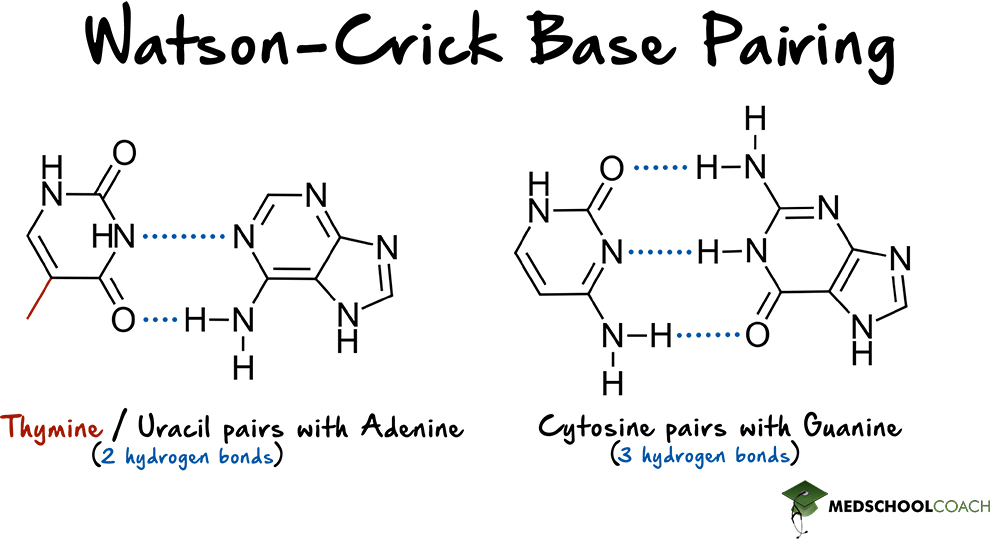The DNA Double Helix
MCAT Biochemistry - Chapter 4 - Section 1.2 - Nucleotides and Nucleic Acids - The DNA Double Helix
- Home
- »
- MCAT Masterclass
- »
- Biological and Biochemical Foundations of Living Systems
- »
- Biochemistry
- »
- The DNA Double Helix – MCAT Biochemistry
Sample MCAT Question - The DNA Double Helix
a) 2
b) 3
c) 4
d) 1
A is correct. 2 hydrogen bonds.
Watson-Crick base pairing refers to the interaction between the nitrogenous bases of DNA. The base pairs between adenine and thymine and adenine and uracil involve only two hydrogen bonds. However, the base pair between cytosine and guanine involve three hydrogen bonds. Due to the higher number of bonds, a cytosine and guanine base pair is more durable than either an adenine and thymine or adenine and uracil base pair.
Get 1-on-1 MCAT Tutoring From a Specialist
With MCAT tutoring from MedSchoolCoach, we are committed to help you prepare, excel, and optimize your ideal score on the MCAT exam.
For each student we work with, we learn about their learning style, content knowledge, and goals. We match them with the most suitable tutor and conduct online sessions that make them feel as if they are in the classroom. Each session is recorded, plus with access to whiteboard notes. We focus on high-yield topics if you’re pressed for time. If you have more time or high-score goals, we meticulously cover the entire MCAT syllabus.
Watson and Crick
In April of 1953, Francis Crick and James D. Watson published an article in the journal Nature entitled, “Molecular Structure of Nucleic Acids: A Structure for Deoxyribose Nucleic Acid.” In this article, they detailed their discovery of the structure of DNA. The Watson-Crick model of DNA, as it has since been called, helps to explain how DNA functions and illustrates the fundamental interactive forces that hold DNA molecules together.
Watson-Crick Base Pairing
Both DNA and RNA are made from nucleotides, which include phosphates, five-carbon sugars, and nitrogenous bases. The interactions between the nitrogenous bases are termed Watson-Crick base pairing. Figure 1 shows the possible combinations of base pairing: adenine with thymine, adenine with uracil, and cytosine with guanine.

It is important to note that the adenine and thymine/uracil base pairs involve only two hydrogen bonds, whereas the cytosine and guanine base pair involves three hydrogen bonds. This difference in hydrogen bonds means that the cytosine and guanine base pair is held together more strongly than either the adenine and thymine or adenine and uracil base pairs. In this way, it would take more energy to break the cytosine and guanine base pair bonds compared to the adenine and thymine or adenine and uracil base pair bonds.
DNA as an Antiparallel Double Helix
The model for the structure of DNA that Francis Crick and James D. Watson developed consists of a double helix formed between two antiparallel, single-stranded DNA molecules (Figure 2).

The so-named “double-helix” refers to the fact that in this model, there are two single-stranded molecules that are bound in a helical shape. Also, it is important to note that the two strands of the double helix molecule are antiparallel. This means that strand runs in the 5′ to 3′ direction, whereas the complementary strand runs from the 3′ to 5′ direction. In other words, the strands go in opposite directions. Furthermore, on the side of the double helix molecule is what is termed the sugar-phosphate backbone, referring to alternating molecules of sugar and phosphate on the outside or “backbone” of the molecule.
Base Pair Interactions
The Watson-Crick DNA model displays how the nitrogenous bases of both DNA strands interact with each other at the center of the double helix. This interaction is favorable because the two strands are complementary to each other based on Watson-Crick base pairing. Where adenine is present on one strand, thymine is on the other strand. Similarly, where guanine is on one of the single-stranded DNA molecules, cytosine is on the other. The strands are held together by the hydrogen bonds between the base pairs.
Also, aside from hydrogen bonds, the two strands of DNA are held together by what is termed base stacking. Base stacking refers to the fact that the nitrogenous bases are stacked on top of each other. Since the nitrogenous bases are aromatic, they can form favorable interactions with the bases stacked above and below them.
Mechanism of DNA Replication
The Watson-Crick model of DNA is important because it implies a simple mechanism for DNA replication. DNA is genetic material, and in order to pass on genetic material to offspring, there has to be some way to replicate it. The double-helix model consists of two single-stranded, complementary DNA molecules. In this way, it would be possible to separate the two strands and use them as templates to create copies of DNA. Doing so would produce two identical copies of DNA, which is what happens during DNA replication.
Explore More MCAT Masterclass Chapters
Take a closer look at our entire MCAT Masterclass or explore our Biochemistry lessons below.

One-on-One Tutoring
Are you ready to take your MCAT performance to a whole new level? Work with our 99th-percentile MCAT tutors to boost your score by 12 points or more!
See if MCAT Tutoring can help me
Talk to our enrollment team about MCAT Tutoring

MCAT Go Audio Course
Engaging audio learning to take your MCAT learning on the go, any time, any where. You'll be on the way to a higher MCAT score no matter where you are. Listen to over 200+ lessons.

MCAT Practice Exams
Practice makes perfect! Our mock exams coupled with thorough explanations and in-depth analytics help students understand exactly where they stand.

MCAT Prep App
Access hundreds of MCAT videos to help you study and raise your exam score. Augment your learning with expert-created flashcards and a question banks.